Hi
Pagosa Springs
After my sunrise hike, I left the park and got on the road toward Durango. I was officially on the home stretch now.
I didn’t spend too much time in the town. I took a walk around the historic downtown district but there wasn’t much of anything that caught my eye. I drove up to the Lion’s Den which had a shelter and offered a great view of the mountains to the west. I posted up there for a little while and did some writing.
The main draw in Durango is the Narrow Gorge Railroad which is an old-school style train that brings you through the mountains into Silverton. My parents took a ride when they were here last year and they loved it.

But I decided against doing it this time around. I missed the earlier train and the timing wasn’t going to work for me later in the afternoon. I haven’t been to Silverton or Ouray yet and I would like to spend more time than a few hours. Maybe I will come next summer and pay it a visit.
Back on the road again by the late afternoon. My original plan was to stop by Chimney Rock National Monument. Another archaeological site. But the monument was closed for the season. I wasn’t sure what that meant exactly.
Were the rangers not around but I could still hike up to the site? Or was the entire area inaccessible? I decided not to take a chance and I moved on toward Pagosa Springs.
That night I found a campsite right along the Piedra River and I did a ton of reading. I also set up the slackline and played around on it for a while. It has been a bit since the last time that I was able to. I managed to make a turn on the line for the first time ever. I was fairly proud of myself.
Pagosa Springs was a much smaller town than I was expecting. It’s only a couple of streets long but it has a beautiful riverfront park. The town is famous for its hot springs and there are a few spa resorts lined up along the river.
There are also a few springs inside the park that are free for the public to access. It’s great that they make those available to the people that might not want to pay for the spa. Perfect for a quick dip on a sunny autumn day.

I thought it was a really great place. It didn’t seem super touristy. I’d like to come back in the summer and check it out during peak season. Probably less crowded than other hot spring areas like Steamboat and Glenwood Springs.
The next day was pretty quiet. I made it over Wolf Creek Pass and took some time at the lookout to check out the surrounding area. The views were really great, even though it was a bit cloudy. The leaves were still in the process of changing here. Pockets of yellow and orange littered the mountainsides in the distance.
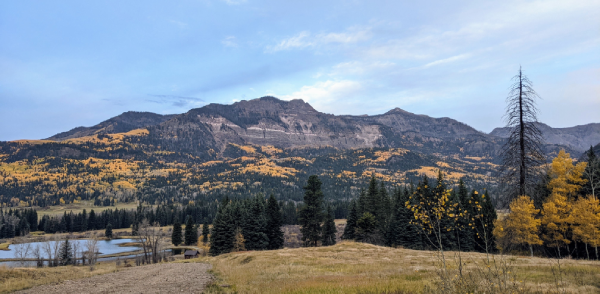
Wolf Creek Ski Area is near the pass and I really want to pay a visit sometime soon. It is known for getting tons of snow. Some would say it gets the most snow of all the ski areas in Colorado. And that’s saying something!
I would love to get out here on a powder day. It’s kind of in the middle of nowhere. so you know that it’s not going to get very crowded either. Sounds like a dream.
Mesa Verde
I found a small BLM campground just outside the park which made getting into Mesa Verde quite easy in the morning. I had a tour of the Cliff Palace scheduled for 9 AM and it took about 45 minutes or so to get into that area of the park.
There are 5 archeological sites within the park that are only accessible via a ranger-led tour. The three most popular are Cliff Palace, Long House, and Balcony House. I couldn’t get a reservation for the latter two but I was still pleased. Cliff Palace is the largest and the most famous of the three.
The group was roughly forty or fifty people large and we all went down the staircase carved into the side of the cliff together. We waited just outside the site while the previous group finished up. One of the rangers gave us a brief history of Cliff Palace and the Puebloan people. It was basically a review of what I had learned at the museum the day before.
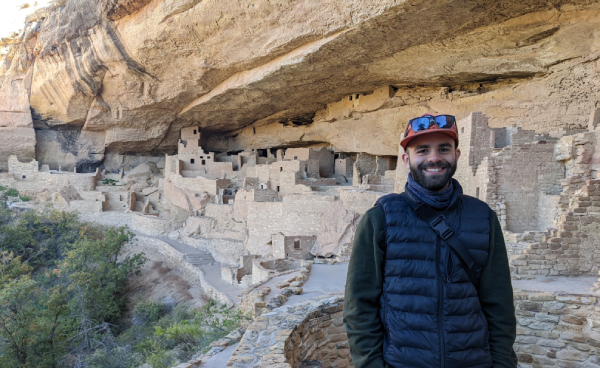
The site was “rediscovered” by the Wetherill brothers in 1888, though the site was well known by the Native population in the area. The brothers were ranchers nearby. Legend has it that they saw the cliff dwelling while grazing their cattle on the plateau. Through a snowstorm in the middle of winter. It’s more likely that they heard about it from the Natives in the area and let others know about it once they located it.
After the discovery, the brothers became amateur archeologists and started studying the site. Other archeologists frequented the area and more and more of these cliff dwellings were found. Over six hundred known dwellings are located here. The area was made into a national park in 1906 in order to protect these sites from theft and vandalism.
The site itself was incredibly impressive. Some restoration has been done over the years but for the most part, the site is made up of the original building materials. About the size of a small city block, approximately 100 people lived at the site at its height.
Originally the Puebloan people lived on top of the mesa in pit houses but over time moved into these cliff dwellings. They were better protected from the elements on the cliffside. And the water supply in these areas was consistent.
The sandstone is porous and when it rains (or when the snow on the mesa top melts) the water trickles down through the sandstone until it gets to a layer that it can no longer pass through. The water pours slowly out of the cliff wall and the Puebloan people used this water. In this way, a water well was practically built into the dwelling.
The people ended up leaving this area and moving south around 1200 AD. Researchers are still unsure why they left but drought and poor farming conditions are probably the best bet. These people traded with other groups throughout the southwest and they probably heard of better living conditions elsewhere from them.
We were able to spend about half an hour at the site and the ranger gave us insight into what some of the different areas of the dwelling were used for. The kiva was the most important room in the dwelling. It was similar to the pithouses that these people used to live in. You could only enter from the roof via a ladder.
The kiva was a community gathering place. At the change of the seasons, men would gather here and perform religious ceremonies and prepare the community. It was a holy place.
Once I finished up at the Cliff Palace I took a drive to a few other lookouts but the cliff dwellings weren’t so easy to see. I finished up the day with the Petroglyph Trail. After a two-and-a-half-mile hike, the payoff point is one of the few petroglyph panels that you can find in the park.
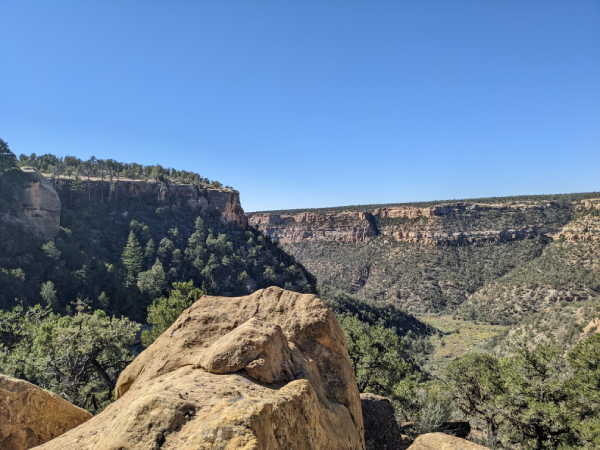
Mesa Verde is not the most beautiful park that I have visited. The main draw is the archeological sites. But the hike was still awesome and I really enjoyed it. Mesa Verde, which means “green table” in Spanish is definitely an appropriate name for the park.
I camped at the BLM campsite that night and made the decision to wake up early and enter the park before sunrise. I got to the top of the Point Lookout Trail thirty minutes before sunrise and sat there and enjoyed the view.
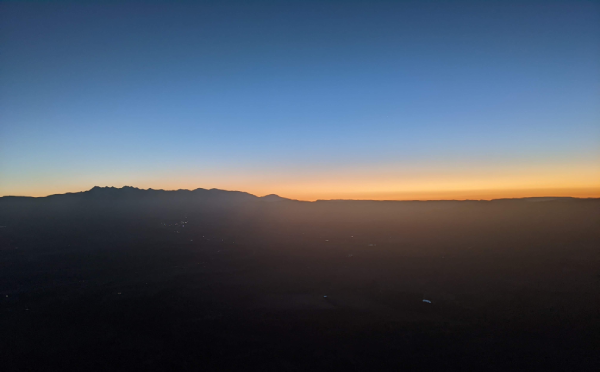
The sun rose over the San Juan mountains and I sat there and just reflected on my trip. From this point on it was back to Denver via Durango and Pagosa Springs.
Canyon Of The Ancients
After hanging out at the Goosenecks I drove north to Bluff. A small town with not much going on. The fort was heavily advertised along the road but it didn’t tickle my fancy. So I drove through and made my way into the Native American reservation.
A half-hour drive down the state highway from Bluff brings you into Montezuma Creek, a town that is in the Navajo Nation territory. I didn’t realize how large the Navajo Nation is. It’s the size of a small country really. At about 28,000 square miles it’s about as big as Scotland!
It’s been a fun little game this summer, finding the cheapest gas. I don’t drive myself crazy but anyone who knows me well knows that I hate overpaying for anything. I am always looking for a fair deal. I find it crazy how the price can vary so widely in a town or city.
The gas on the reservation was so much cheaper than in Bluff. The reservation isn’t subject to the same taxes and it shows. I’d imagine anyone that lives in town gets their fuel here as well. I was pleased.
There wasn’t any reason to stay in town and I moved north to Hovenweep National Moment. I hadn’t heard of it until I was browsing the map, looking for a place to camp for the night. There are so many small national monuments out here.
The main draw here is the Puebloan ruins. The buildings are roughly 800 years old and they are in incredible condition. The town was built along the rim of this small gulch. There are a few buildings down at the bottom of the gorge as well. A good way to warm myself up for Mesa Verde National Park.
The four corners region (where Utah, Colorado, New Mexico, and Arizona meet) is filled with ancient Puebloan archeological sites. Mesa Verde is the most well-known and the only national park in the area. But there is also Hovenweep National Monument and Canyons of the Ancients National Monument as well.
Canyon of the Ancients covers a huge area of land at around 175,000 acres. There are over 8,000 identified archeological sites that have been identified and more are being found all the time.
I woke up early in the morning the next day, did some yoga with the sunrise, and hiked the trail around the gorge and through the ruins. Had the entire place to myself and it was very peaceful. I tried to imagine how the communities lived 800 years ago.
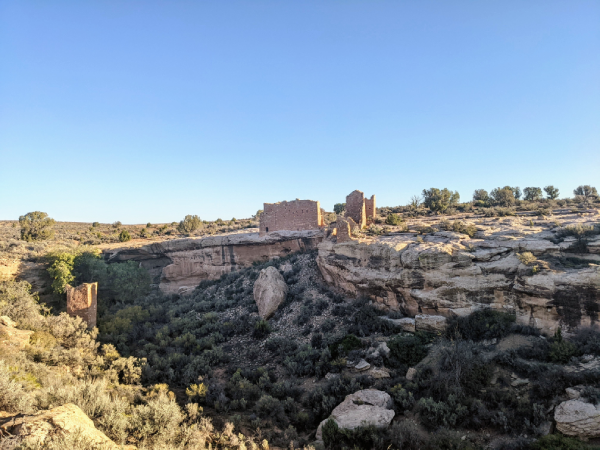
There weren’t any of the famous cliff dwellings in this area but the buildings themselves were impressive. There were towers and long houses and there was also this building that seemed to be built into a hollowed-out boulder.

Once I finished up I crossed the border into Colorado and went to the Canyon of the Ancients visitors center. It really is more of a museum covering the ancient Puebloans and the history of archeological discovery in the area.
The museum was very thorough and I enjoyed learning about the customs and legends of the Native Americans that lived in the area. It was also cool to see how the ways that these people lived and formed their communities changed over time.
Originally they built their dwellings underground and they would enter and exit through a hole in the roof. Building in this way kept them cool and helped protect them from the harsh weather in the desert. Eventually, they graduated to above-ground dwellings. And after that, some of the people moved into cliff dwellings, like the ones you find in Mesa Verde.
The visitor’s center is located close to an archeological site. I climbed the hill to go check it out but there wasn’t much to it. Only the base of the buildings that once stood there remained. But the views from the top of the hill were fantastic.
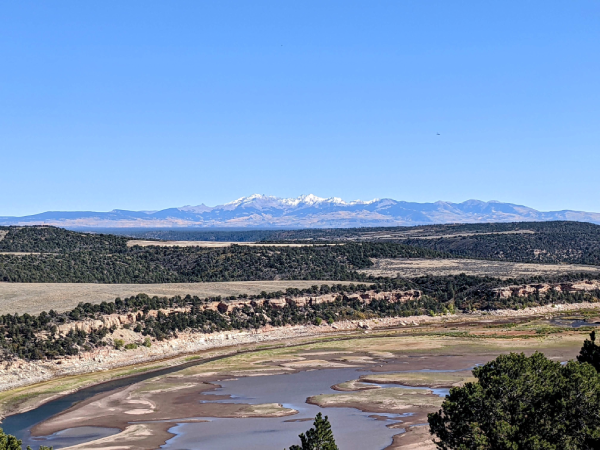
To the south, you could see Sleeping Ute Mountain. The natives have a legend that explains the formation of the range. And to be fair it looks like a sleeping man. If you squint really hard. To the east, I could take in the San Juan mountains. Snow-capped already. It got me thinking about ski season.
Valley Of The Gods
From the National Monument, I drove about an hour south on the state highway to Moki’s Dugway. It’s a steep section of road that gets you from where you are on the plateau down into the valley.
All the signs on the road in were hyping this thing up. No RVs or trucks allowed. Steep grades and sharp turns. I figured it was going to be difficult to navigate. To be honest, I was a little nervous. But it was just a normal dirt road that slowly meandered down the cliffside. Really beautiful views from the top.
I was close to the Valley of the Gods at this point. The area is BLM which means free camping. My plan was to drive and find a campsite and then drive out the next day and make my way to Mexican Hat.
The road was a lot rougher than I was imagining it was going to be. Some deep ruts and holes in the road to navigate. I was worried about some of the cars behind me with low clearance. It must have been affected by the flash flooding that affected the national monument trail.
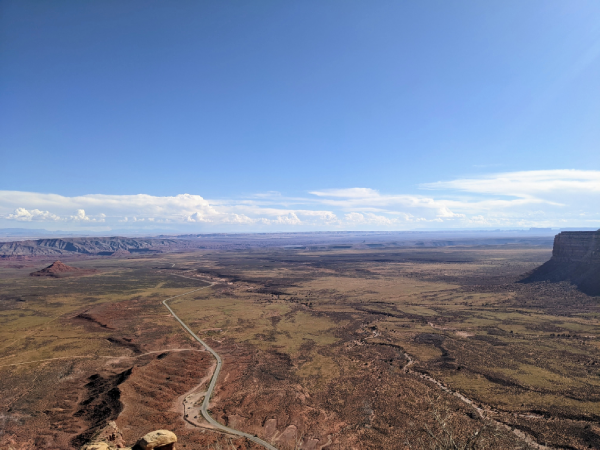
The drive in is beautiful but pretty standard for Utah. It’s not until you get to the 8-mile mark that you understand why this is the place to be. Two giant buttes dominate the terrain here. The road meanders back the way it came and you can drive between the two structures.
I was able to find a campsite right near Castle Butte which was the geologic feature I liked the best. I was able to sit there all day and take in the view. When you imagine the desert in Utah this is what you see. When you look closely you can see the exact places in the rock where the water would work its magic over time. It was very cool to take in.
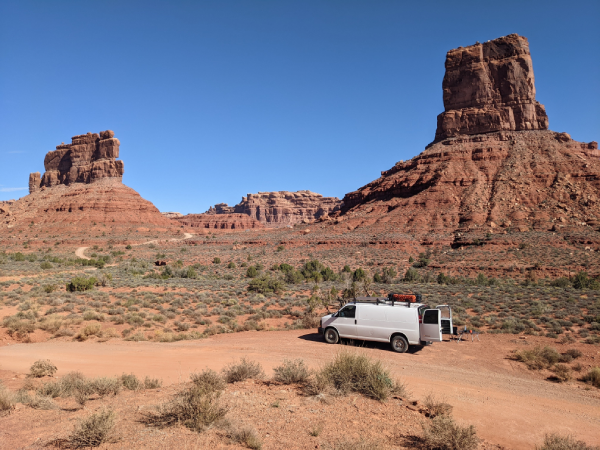
I had a lazy morning and then drove down to Mexican Hat in the early afternoon. Not much going on in the town itself. There is a small rock formation that, admittedly, looks like a head with a large sombrero on. Hence the name of the “town”.
I originally intended on going down to Monument Valley which is south of Mexican Hat on the Navajo reservation. About an hour and a half away. But I decided against it. I will come back and pay it a visit. I was done with desert buttes for the time being.
Instead, I went to Goosenecks State Park just outside of the town. It’s a view of a double horseshoe bend created by the San Juan River. You pay 5 dollars and you get to take in the view. I set up the grill and made lunch.
The sign said that this area is one of the best examples of a meandering river in the world and I believe it. A good spot to set up the grill and make lunch.
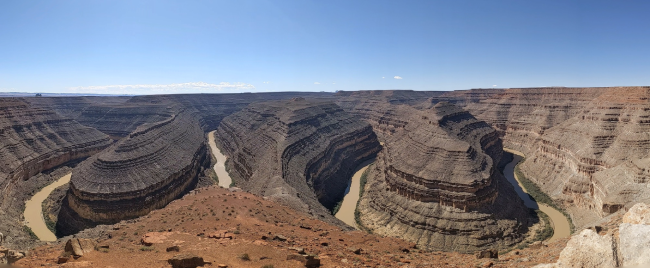
There was only one picnic table with shade and the sun was very strong. I sat down to eat at the same time a bus full of tourists parked up. They sat with me and I was integrated into the group for a short while. They were from Spain and most of them could not speak English.
I was able to communicate with them and get my story across. To a few of them at least. My ability to communicate in Spanish still exists but there is room for improvement. I want to spend some time getting back into it. Reading and listening are activities I should be doing a few times a week.
The Needles
Canyonlands National Park is broken up into 3 different areas – Island In The Sky, The Needles, and The Maze. The former is the most accessible. An easy drive from Moab and not many long hikes to see the best areas of the park.
The latter is extremely difficult to access. There are no paved roads in this area and they recommend traveling in groups in case you get stuck. The terrain is extreme and you need a heavy-duty off-roading vehicle.
But the Needles, though remote and out of the way, is accessible via a state highway. And that was the next stop.
On the way back from Island in the Sky I stopped in Moab briefly to run some errands. I was thinking of grabbing lunch with Lynn and Mark (the older couple that helped me out when I got stuck in the La Sal mountains). But I was enjoying my alone time so I decided against it. I’d like to see them again and I will contact them when I am back in Utah in December.
I started my journey south in the mid-afternoon and it took me about an hour to get to the campground. Stayed at a developed BLM campground the first night and the views of the valley and the monoliths in the distance were amazing. I took it easy that evening because my plan was to go on a long hike the next day.
The Needles are named after the geologic rock formations in this area of the canyon. There are a lot of long spires of eroded rock and they resemble needles (kind of). You can see the different layers of rock that make up the structures and each layer is a different color. It creates a very unique look.
Cracks, moving in opposite directions, formed in the area many years ago. Before the rock eroded the cracks created a grid-like structure on the upper layer of the rock. As erosion ran its course, it slowly deepened these cracks until these tower-like structures were all that remained. That is what we see today in this area.
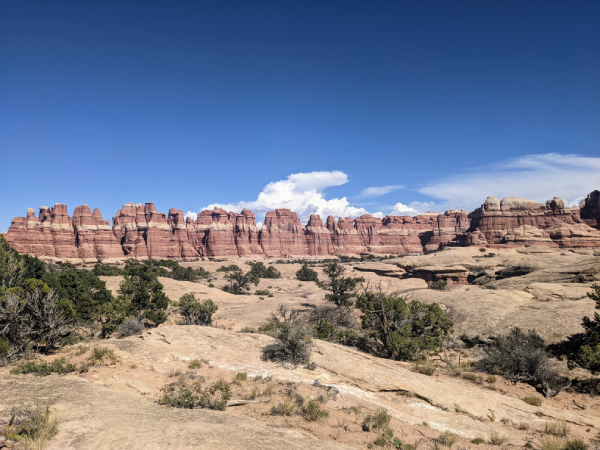
This part of Canyonlands has the most hiking trails and I was excited to get my legs moving. There are many trails that weave their way in and out of the canyons and it creates a labyrinth of sorts. Many people backpack for two or three nights but I wasn’t prepared to do that. So I decided to make a very long day hike instead.
I decided to go to Druid Arch first. It’s a little out of the way but I wanted to do something challenging so I went for it. You start at Elephant Hill trailhead, walk about 1.5 miles into the labyrinth of hiking trails, and then work your way south another mile until you get to the junction.
From there it’s another 2.5 miles to the arch. Canyon hikes are fairly straightforward – the canyon is the trail so it’s quite difficult to get lost. And the elevation gain is minimal. There was a lot of sand to walk through and tight cracks in the rock to navigate. So that slowed me down a bit.
As you get closer to the arch you have to do a bit of climbing and scrambling. Nothing too technical. But if you are not strong enough you might have to turn back. It was a proper adventure.
The arch itself was fairly large and you can scramble up a section of rocks to a platform with great views of it. It was kind of two arches in one, as there were multiple “holes” (if that’s the right word) created by erosion. It looked like a modern art sculpture to me.
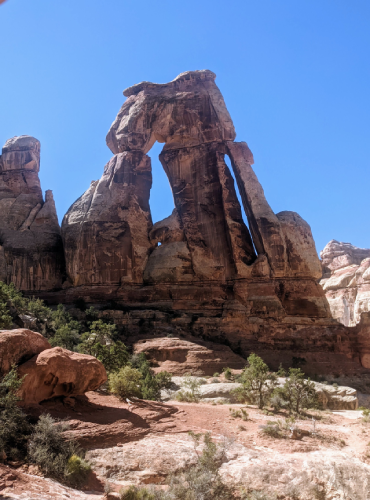
I rested for a bit and had lunch. And then from there, I cut into the Chessler Park loop. I was able to take a shortcut that I didn’t see on the map. I kind of just stumbled upon it as I was walking back. It was one of the cooler sections during the hike. You have to navigate several ledges and caves to pass from one canyon to the next.
Once you are back on the main trail you are dumped into this open space. And you have this excellent view of all the stone spires. They completely enclose this area it seems. You walk around this one wall and you begin to move into Chessler Park.
Really worth the hike in here. It is a grassland here, with shrubs, small junipers, and pinyon pine trees. It is definitely a bit out of place but that’s what makes it so awesome. And it’s almost like you are pinned in (no pun intended) by the needle formations. You almost feel like you are in a very large stadium.

The walk back to the trailhead was fairly straightforward. Mostly along the trails I had walked on earlier in the day. All in all, I walked roughly 13 miles and it took me about seven hours.
I was pretty sore the next day. That’s what happens when you haven’t been moving as much. i wanted to do the Confluence Overlook hike. But I decided against it. It is another 11 miles and the ranger at the visitor center said it might not be worth it.
I just moseyed around the other areas and did some smaller hikes. The small loop at Pothole Point has amazing views of the needles. And the Cave Spring Loop had some awesome views as well from a distance.
Island In The Sky
Back on the road and this time I’m all on my own. It’s an odd feeling honestly. You spend every day with someone and just like that you’re doing your own thing again.
I left on Tuesday afternoon and drove west to the Island of the Sky district in Canyonlands National Park. Ifound some BLM land just outside the entrance and I camped there. Really convenient location but not much in terms of things to look at. Making dinner and cleaning everything is a bit more difficult when you have no one to help you out. The new reality.
I was sitting outside reading a book after cleaning up, enjoying the desert sunset and all that, and this man from a campsite down the road walked up. He was looking for a cell phone signal but he stopped to chat with me for a bit.
He and his family are from Switzerland and they have been traveling in the US and Canada for close to a year now. They shipped their campervan from Europe to Canada and I had plenty of questions about that. He told me a ton of Europeans have done it since the start of the pandemic. And it was not very expensive either.
They have two children and they are slowly moving south with the intention of going to Mexico. Mostly on dirt roads – staying away from the major highways. I asked him about traveling with young children (his were 2 and 3 years old). I’ve seen plenty of people do this but I’m not sure how they manage.
He said it was challenging but that’s the life they have chosen and it is working out for them. It was nice to meet someone new and have a chat with a stranger. Especially my first night on my own.
I got into the park fairly early but I son learned that it wasn’t entirely necessary. There are tons of overlooks in this part of the park. But all of the trails are super short here.
So that’s what I did. I took the short walk to an overlook, took a break, and then drove on to the next one. Rinse and repeat. You probably only need 4 or 5 hours to make it to everything worth seeing in this area of the park.
It did get a bit boring by the mid-afternoon, I’m not going to lie. I think it’s a combination of being alone for the first time and not having a challenging hike to do in this area. By the third overlook, you really lose that “wow” factor.
Anyway, I went to Mesa Arch first and did the short walk up the hill to the lookout. It’s the most famous feature in the park and a good place to be for sunrise. The arch stands right on the cliff and you can look through it like a window and see the views of the canyon below.
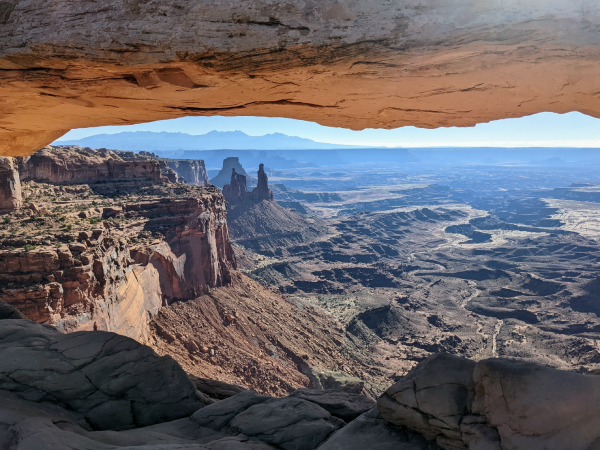
They had a ton of infographics identifying the plant life on the trail and that’s something I’d like to get better at. Being able to identify plant life while walking around. I’ve been traveling for about 5 months now and I don’t even know what types of trees I’m looking at sometimes! I think that’s silly.
The second stop was Upheaval Dome, which actually is a trail to two separate viewpoints overlooking a crater. Geologists still can’t say for certain how the crater came to be. They believe it was created by either a salt dome that collapsed on itself or a meteor strike. They lean meteor strike and I do too. Not that I know what I am talking about. It just seems cooler.
I was thinking of taking the trail around the crater. It gets you to a point where you can hike into it. But it was an 8 mile trail and fairly hot by the time I arrived. I figured I would save my energy for some other hikes later in the week.
From there it was just about hitting all the viewpoints in the southern portion of the part. Green River and White Rim were my favorites. Green River had the best view of them all. And the White Rim trail was super unique.
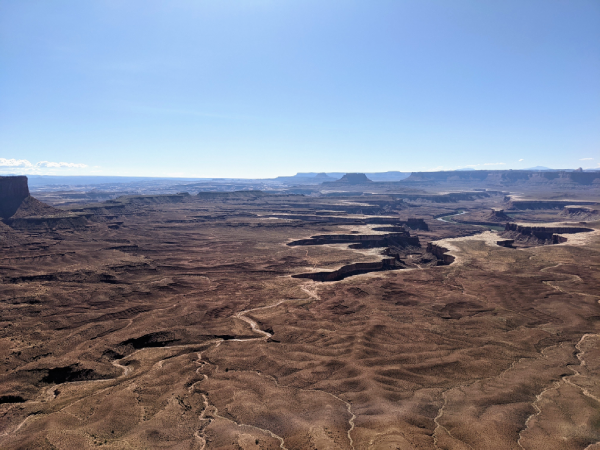
The rock layer on the rim of the canyon below the vantage point looks almost like it is made of salt. The rock is a different type of sandstone and it makes up one of the many layers of the canyon. It just hasn’t eroded yet and it coats the rim of the lower canyon.
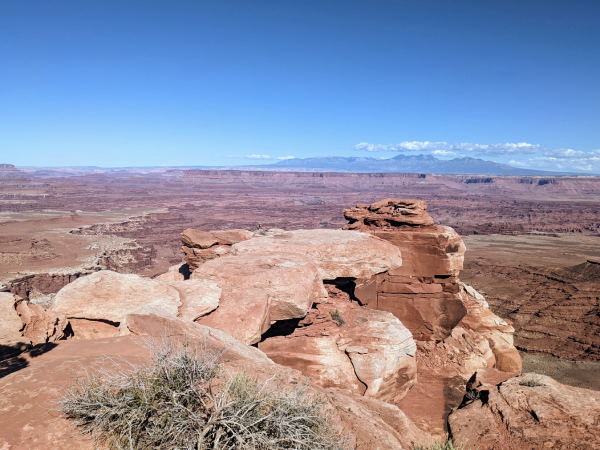
The Grand View Point trail is the most popular and it is about two miles out and back. Just a stroll along the rim. The views to the east were great in the late afternoon light. But the visibility west wasn’t so good because the sun was in my eyes. Definitely, a hike to do in the morning if you want good views in that direction.
Back To Colorado
The original plan was to travel through October. In my head, we would be back in the Colorado area in early November. But by the time we got to Seattle we were both feeling exhausted. It was especially difficult for Amanda. I give her credit for being able to balance work and travel for so long. To continue to do that for another month and a half was not feasible.
We also started to realize that it was becoming difficult to be present and make the most of our time in all these amazing places we were visiting. It’s impossible to have the experiences you want to have when you don’t have the energy to explore the way you want to. So we decided to head back earlier than expected.
It took us about six days to get to Grand Junction from where we were in Washington. Roughly twenty hours of driving. That’s about 1,300 miles in a week. It wasn’t an easy drive by any means.
We made a big push in the first few days. We drove about 4 hours from Forks to Longview on Sunday and then another 4 hours into central Oregon the next day. Not much to note here. We got a hotel in Longview. We needed it after being on the Olympic Peninsula for two weeks. And with the big drive ahead of us, we needed to get some rest.
After three days we were back in Twin Falls, where we decided to stop and get an AirBnB for a few days. It made a lot of sense for us because it was a place we were already familiar with. We had spent close to a week here in June and it was an area we enjoyed being in.
From there we had two more days of driving. We passed through Salt Lake City but we didn’t stop there. I had already been there before I met Amanda. And she didn’t have an interest. Not really much to see there unless you go into the mountains and do some hiking.
We decided to pass through Moab as we made it closer to Colorado, even though it was a little out of the way. The place where we met and this entire adventure started for the two of us. We took a bit of a detour to Dead Horse Point State Park. We did the hike around the rim of the canyon and the views of the Colorado River were really great.
Lots of mountain bikers here. The Moab area is a great place if you like to bike. I am not the strongest biker myself but maybe I will get better at it during the downtime I will have later this year. And if I get good enough maybe I can take up mountain biking too.
We weren’t able to find a campsite along the river close to Moab. It was the weekend and the fall is the best time to visit the area. The weather is perfect. So we drove further and further down the river road until we hit Onion Creek. We were able to snag the last campsite here.
That night, as the sun was setting, a storm rolled in. You could see the dark clouds slowly getting closer and closer to where we were. We made dinner and then we decided to hang out and watch the thunderstorm in the distance. A really good light show – no lie some of the best lightning I have ever seen. It reminded me a lot of the times when I would hang out on Alexandra’s balcony and watch the thunderstorms go off in the distance.
It rained a little by us but not enough to cause any issues getting out of the campground. I was a little concerned that the campground would flood because it was all clay. And there were already places that were waterlogged from the storms a few days prior. But we made it out alright.
The next day we were back in Grand Junction by the early afternoon. We had a reunion with Tom and his girlfriend and shared a few stories. I stayed there for two nights so I could rest up before my last leg of the trip.
It’s amazing how much space I have in the van now that Amanda has taken all of her stuff out. Funny how your perception changes. When I was traveling by myself I always felt that I didn’t have enough room for all the things that I wanted to bring. And now I feel like I have too much space.
It was a sad moment when I was leaving on Tuesday afternoon. We have spent the better part of three months traveling together, Amanda and I. You really get in the habit of being in this person’s presence. And that was about to change.
We both understand that it is going to be healthy to get some space from each other. But it will be a small challenge trying to adapt to traveling by myself again over the next few days.
Hoh Rainforest
The Hoh Rainforest is roughly in the middle of the Olympic Peninsula. But you can really only get to it from the Pacific coast or from the south. So it was naturally our next stop after spending some time in La Push.
This place receives over 12 feet of rain per year and the health of the forest really shows.
The rainforest itself is not the biggest hiking destination which was a bit disappointing to me. You have a thru trail there that is roughly 35 miles long and not much else. So the only big day we were able to do was 4 or 5 miles on that thru trail.
The forest itself was pretty amazing but it didn’t seem much different than the other rainforests we had seen on the other side of the mountains in Fairholme. You hear so much about the Hoh Rainforest and you are expecting something out of this world. But the reason you hear so much about it is that it’s just more well-known than the other parts of the park.
The Hall of Mosses, which was a really short hike in the area, was fairly special. There was a small creek that ran through it and the underwater plant life was mesmerizing to watch.
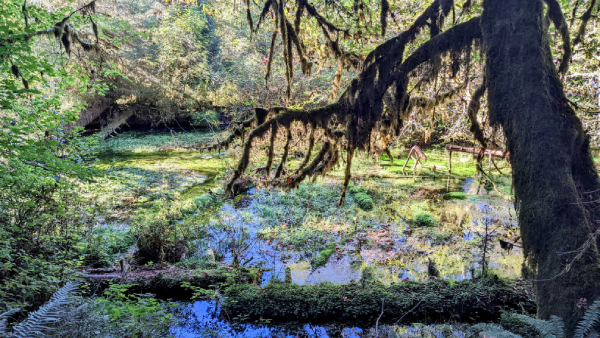
You can walk a quarter mile up the hill and it brings you into the oldest part of the forest. Here there were some beautiful maple trees draped all over with moss and lichen. It’s what I pictured the rainforest would look like. Felt like we were in a mystical world at that point. Like Lord Of The Rings or something.
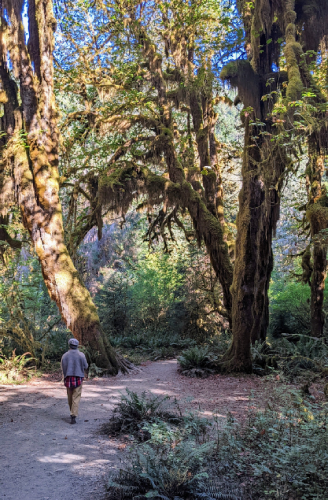
We camped there that night. Not in the rainforest but in an open clearing. I had high expectations of this place but I was a bit disappointed again. I guess coming in with high expectations isn’t always a good thing. Had a solid night with a campfire and everything. The stars were really amazing. We hadn’t had many nights with great stars in Washington because of all the forest fires.
The next day we moved about 45 minutes down the coast (you only really need a day in the forest) to Ruby Beach. Real similar to Rialto and Second Beach. Bunch of really big rocks on the beach. We did a meditation on the beach with each other and that was really enjoyable.
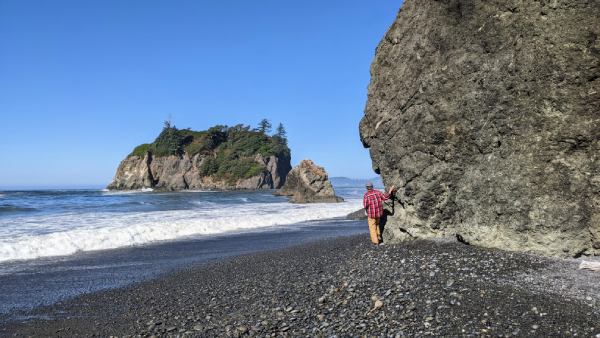
From here on out we were officially on the road back to Colorado. We picked up a hotel for the night in Longview Washington. Right near the border with Oregon.
Rialto Beach
Neah Bay to Forks was about an hour and a half drive. Had to go back to Clallam Bay to get there. Didn’t stop in the food co-op, needless to say.
Forks is a bit more run down than I thought it would be. A pretty consistent theme on the Olympic Peninsula. You think where there is a national park you would have some level of amenity. Especially one as well known as Olympic.
Fun fact though. They filmed some of the scenes from Twilight here. The teenage vampire book series turned film. And they definitely embrace their claim to fame. Merchandise and little gift shops everywhere. One supermarket and about five of these shops completely dedicated to Twilight paraphernalia. Go figure.
We were here to visit Rialto Beach, which is one of the many beaches that make up this stretch of coastline. Probably the most well-known though. Here you can find the Hole In The Wall. It’s exactly what it sounds like. It’s a hole in the wall of one of the larger rock features on the beach.
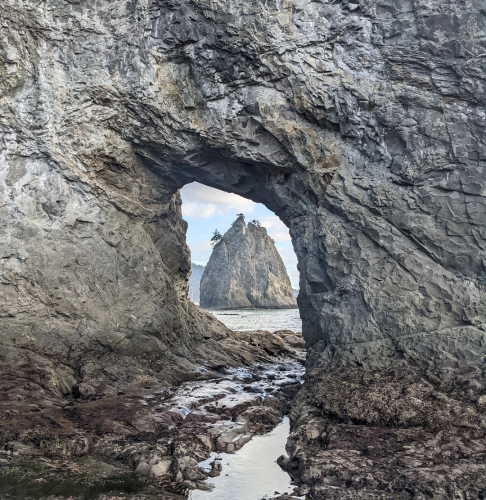
We stayed in the campsite right by the beach and it worked out really well for us, outside of arriving to find someone camped out at the site we had reserved. I spoke with the ranger and they said they couldn’t do anything about it. They weren’t allowed to move someone’s belongings.
So she gave us a new site and it worked out rather well for us. It was a better site than the one we had reserved. Further away from the construction they were doing near the river.
In order to get to the Hole In The Wall, you walk about a mile down the beach. Just like most beaches out here, it is littered with the remains of hundreds of gigantic trees. It’s a national park so there were a handful of people around.
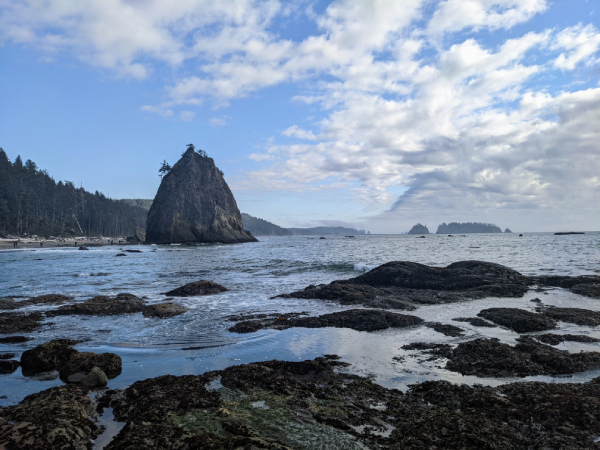
You get to the Hole In The Wall and you have a bunch of people trying to get the perfect picture. I have mixed feelings about it. I want to get a good picture as well but there is a line you need to stay on the right side of. If you’re taking several minutes and taking several pictures then you might be ruining the experience for others.
The low tide was in the late afternoon for the entire time that we spent in this area and that worked out really well. Amanda could get her work done and then we could get over to the beach at about 3 or 4 o’clock so we could check out the tide pools.
The next day we went to La Push, a small town just south of Rialto Beach. It’s part of the Quileute Native American reservation. There are three separate beaches located in the town that have similar rock features to Rialto Beach. But unlike the Makah reservation in Neah Bay, no recreation fee was required.
So we hiked to Second Beach the following day and the rock formations here were probably my favorite of all the beaches we have been to on the trip. The tide pools here were also very good and we saw the biggest starfish we have seen thus far. Amanda was still looking for a sea urchin (it was her last chance) but we never found one, unfortunately.
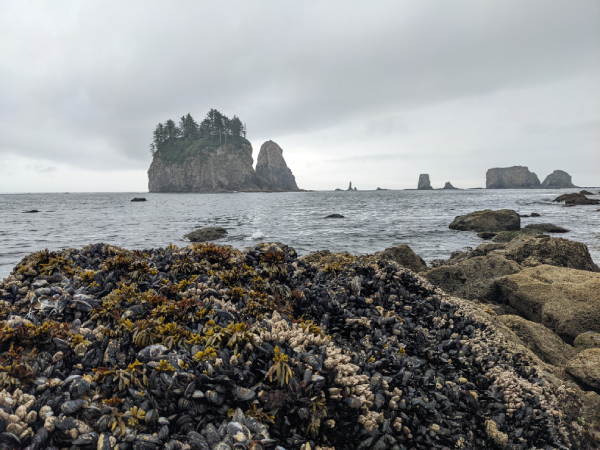
While on the beach it began to rain fairly hard. So we definitely got the Pacific Northwest beach experience. We were soaked but we didn’t rush off the beach. It’s fun to get caught in the rain sometimes.